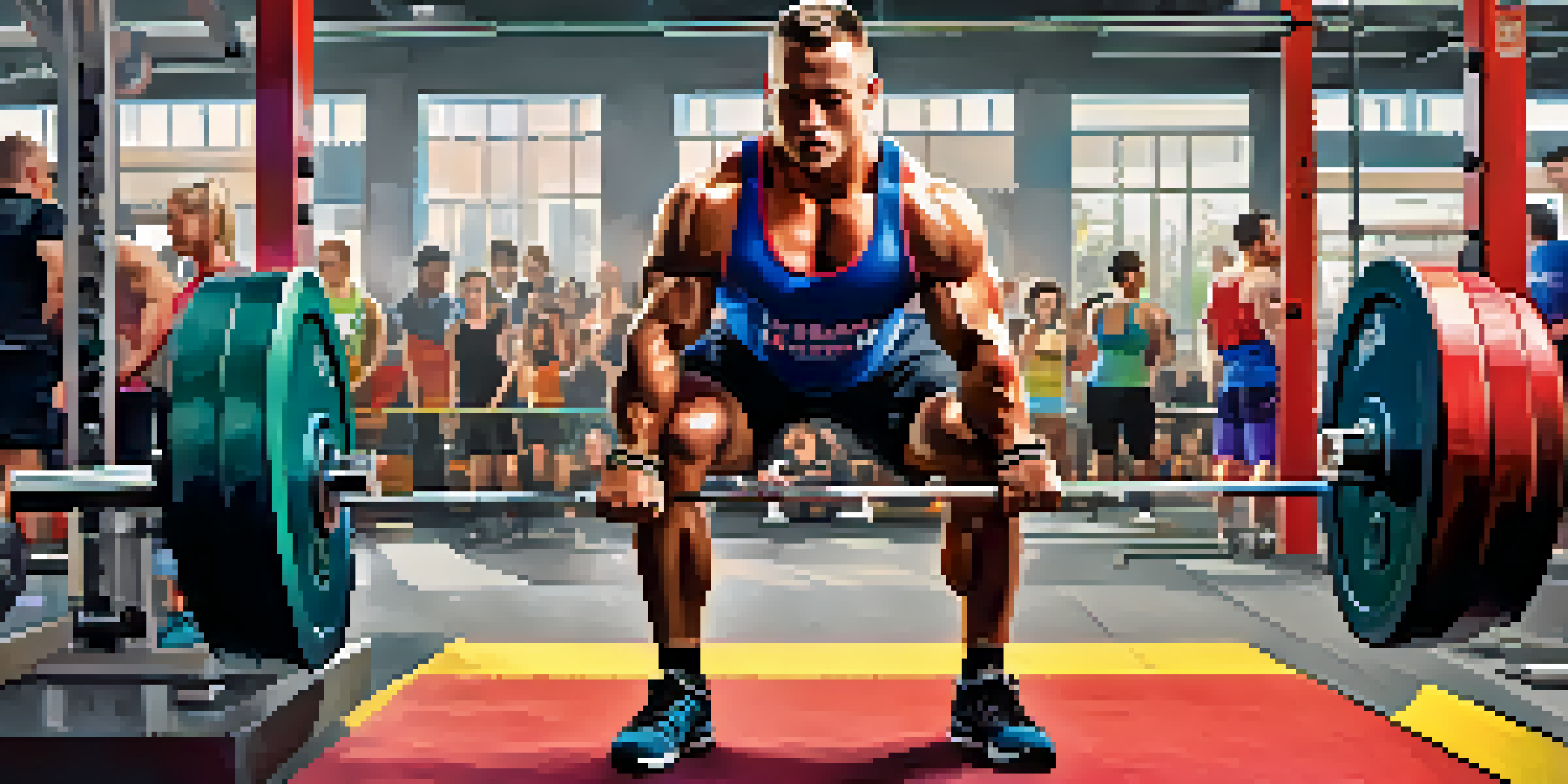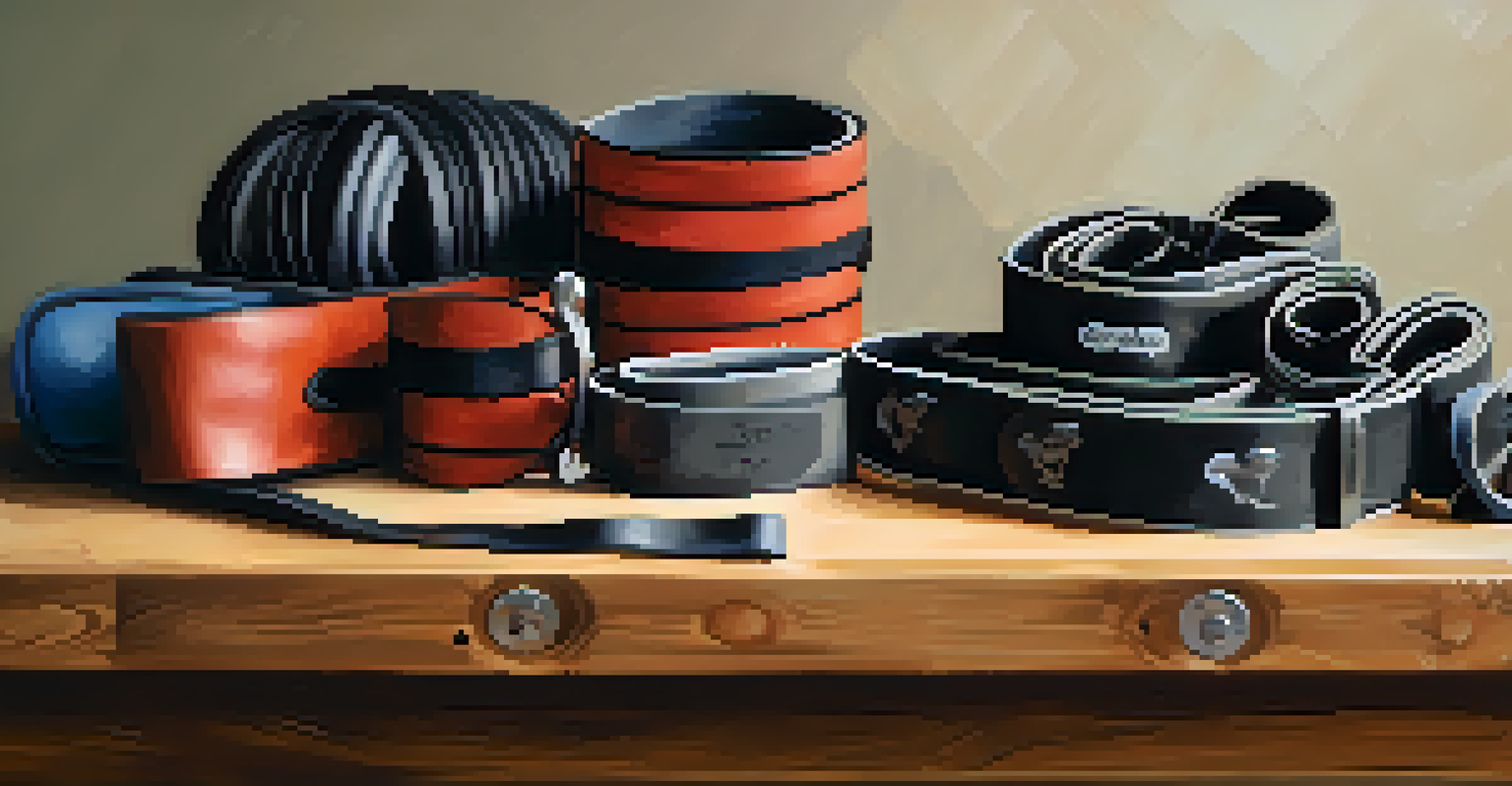How to Choose the Right Gear for Powerlifting Competitions

Understand the Rules and Regulations of Competitions
Before diving into gear selection, familiarize yourself with the specific rules and regulations of the powerlifting federation you'll be competing in. Different organizations may have unique guidelines regarding the types of equipment allowed, which can significantly affect your choices. For instance, some federations may permit knee wraps while others do not, or they might have restrictions on the type of lifting shoes you can wear.
Success is where preparation and opportunity meet.
Knowing these details is essential because it ensures your gear complies with the competition standards. Imagine preparing for a big game, only to find out your uniform doesn’t meet the requirements—frustrating, right? By understanding the rules early on, you can avoid potential disqualifications and focus on performing your best.
Additionally, each federation might classify gear into different categories, such as raw or equipped lifting. Raw lifting typically means using minimal supportive gear, while equipped lifting allows for more specialized equipment. Clarifying these distinctions will help you make informed decisions as you gear up for competition day.
Choose the Right Lifting Shoes for Stability and Support
Lifting shoes are crucial in powerlifting as they provide the necessary stability and support during your lifts. Look for shoes with a flat sole and a raised heel, which can enhance your squat depth and overall lifting mechanics. Brands like Adidas and Nike offer popular options designed specifically for powerlifting, catering to various foot shapes and preferences.

Consider the fit of the shoes as well; they should feel snug but not too tight. A good fit allows for optimal power transfer while minimizing the risk of injury. Just like how athletes need the right cleats for their sport, powerlifters should invest in shoes that can withstand the demands of heavy lifting while providing comfort.
Know Competition Gear Rules
Understanding the specific rules of your powerlifting federation is crucial to ensure your gear complies and avoid disqualifications.
Don't forget about the grip! The sole should provide enough traction to prevent slipping during lifts. Picture trying to sprint on a slippery floor—it's not just ineffective, it can be dangerous. Your lifting shoes should enhance your performance, ensuring your feet stay firmly planted as you push your limits.
Select the Right Belt to Improve Core Stability
A lifting belt is a staple in powerlifting gear, designed to support your core during heavy lifts. When choosing a belt, look for one that is at least 4 inches wide and made from sturdy materials like leather or heavy-duty nylon. This type of support can help you maintain proper form and reduce the risk of injury while lifting heavy weights.
In sports, you can only be as good as your equipment.
It's also essential to consider the thickness of the belt. Many lifters prefer a thickness of 10mm for optimal support, but you might find that a 13mm belt works better for your lifting style. Try out different options to see what feels best for you—after all, comfort plays a key role in performance.
When you wear a belt, it’s like having an extra layer of protection for your body, allowing you to lift heavier with confidence. Just as a seatbelt keeps you secure in a car, a lifting belt stabilizes your core, letting you focus on the lift itself rather than worrying about potential injuries.
Invest in Quality Knee Sleeves for Joint Support
Knee sleeves are another essential piece of gear in powerlifting, offering support and warmth to your knees during lifts. They are made from elastic materials that provide compression, which can help improve blood flow and reduce the risk of injury. When selecting knee sleeves, look for ones that have a snug fit without being overly tight.
Choosing the right thickness is crucial; many lifters opt for 5mm or 7mm sleeves, depending on their preference and lifting style. Thicker sleeves may offer more support but can also limit mobility, so it's essential to find a balance that works for you. Think of knee sleeves as a cozy hug for your knees, keeping them safe while you push through those heavy sets.
Choose Quality Supportive Gear
Investing in the right lifting shoes, belts, and sleeves enhances stability, support, and performance during your lifts.
Additionally, make sure to check the durability of the sleeves. A good pair should last through numerous training sessions and competitions. Investing in quality gear means you won’t have to worry about your equipment failing you at crucial moments during your lifts.
Pick the Right Singlet for Competition Readiness
The singlet is the official attire for powerlifting competitions, and choosing the right one is essential for both comfort and performance. Look for a singlet made from moisture-wicking fabric that allows for a full range of motion. It should fit snugly without being restrictive, enabling you to perform at your best while also adhering to competition rules.
When selecting a color or design, consider your personal style. While the primary focus should be on functionality, feeling good in your gear can boost your confidence. Just like a superhero has their signature costume, your singlet can make you feel empowered as you approach the platform.
Lastly, check the length of the legs on the singlet; some federations have specific requirements regarding this. Whether it’s sleeveless or long-sleeved, your singlet should not only comply with regulations but also make you feel like the best version of yourself on competition day.
Don't Overlook Wrist Wraps for Extra Support
Wrist wraps are often an afterthought, but they can play a vital role in your lifting routine. These wraps provide essential support for your wrists during heavy lifts, especially in the bench press and overhead movements. When selecting wrist wraps, look for options that offer a balance of flexibility and stability.
A good pair should be snug enough to provide support without restricting movement. Think of wrist wraps as a safety net, allowing you to focus on pushing your limits without worrying about potential injuries. They act like a trusty sidekick, stepping in to help when the weights get heavy.
Test Gear Before Competition
Familiarizing yourself with your gear during training sessions helps build confidence and identify any issues before competition day.
Consider the length of the wraps as well; longer wraps can provide more support, but they may also take longer to wrap, which could be a factor during competitions. Ultimately, finding the right wrist wraps is about personal preference and what makes you feel secure while lifting.
Test Your Gear Before Competition Day
Once you've chosen your gear, it’s vital to test everything out before competition day. This includes wearing your singlet, shoes, and any supportive equipment during your training sessions. Getting comfortable with your gear helps ensure you know how it feels and fits, allowing you to make any necessary adjustments ahead of time.
Imagine walking into a competition wearing gear you've never tried before—talk about nerve-racking! By incorporating your gear into your training, you can build confidence and familiarity, ultimately leading to better performance when it counts. It’s like rehearsing for a big show; the more you practice, the less anxious you feel when it’s time to shine.

Additionally, testing your gear can help identify any potential issues, such as discomfort or restrictions in movement. If something doesn’t feel right, you have time to make changes or choose different equipment. Remember, the right gear should enhance your performance, not hinder it.